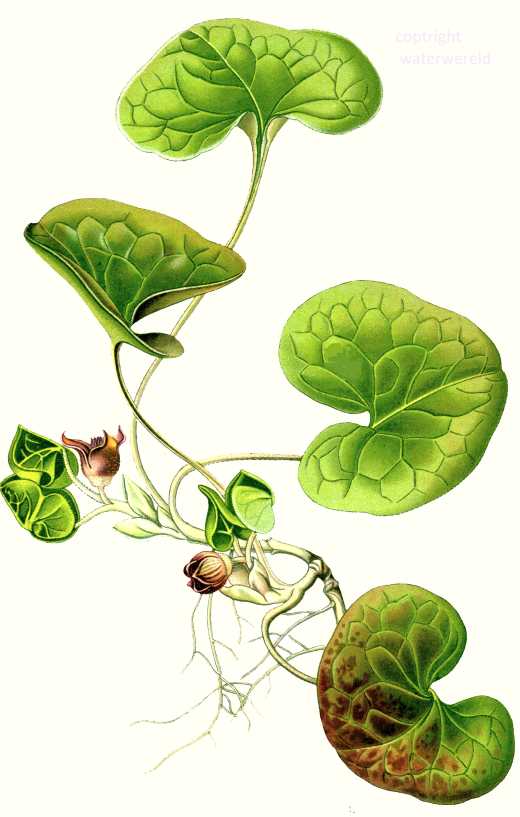Asarabacca or hornwort
Asarabacca is a fastly growing ground covering evergreen perennial that can be found in moist soil. Here it grows even in full shadow on sandy poor grounds. Asarabacca is useful ground cover for a shady parts of the garden as long it is not dry. Asarabacca can be found in beech woodlands.Asarabacca leaves
The plant has a strong peppery taste and smell. The dark green leaves have the form of an ear. The leaves form an attractive foliage. Although it is capable of growing in the full shade, Asarabacca is slow to increase is size.asarabacca flowering
Asarabacca flowers early in the spring with almost invisible small malodoreus red flowers.reproduction of asarabacca
Asarabacca spreads quickly by its roots. Vegetative reproduction of Asarabacca can be done most easely by cutting the stem.confusion with other Asarum
Asarum caudatum en Asarum canadense look very similar and can be confused with hornwort.
Asarabacca or hornwort or Asarum europaeum has small red flowers.
These flowers are almost invisible from above, the leaves cover them. Pollination is done by flies, who are attracted by the bad smell of the flowers.
Asarabacca is poisionous
Fresh Asarabacca is poisionous. A very strong pepper taste prevent the leaves from being eaten by rabbits. Asarabacca should never be eaten as it is a strong poision for the kidneys.
Asarabacca and the common liverwort.
Asarabacca has smooth leaves on large stalks, dark green on top and pale yellow underneath.

The bottom of the wood , from: Meyers lexikon 1904
1 Lingonberry or Cowberry or Vaccinium vitis
2 Belladonna or Deadly Nightshade or Atropa belladonna
3 Common Hepatica, Liverwort, Kidneywort or Pennywort or Hepatica triloba
4 Narrow-leaved Helleborine or Cephalanthera longifolia
5 Herb Paris or True Lover's Knot or Paris quadrifolia
6 Northern Wolfsbane or Aconitum lycoctonum
7 Lungwort, Common Lungwort or Our Lady's Milk Drops or Pulmonaria officinalis
8 Common Ivy or Hedera helix
9 Asian Goatsbear or Aruncus sylvester
10 Wild Strawberry or Fragaria vesca
11 Perennial Cornflower or Centaurea montana
12 Bird's-nest Orchid or Neottia nidus
13 Common Wood Sorrel or Oxalis acetosella
14 Asarabacca, European Wild Ginger, Hazelwort or Wild Spikenard or Asarum europaeum
15 False lily of the valley or May lily or Maianthemum bifolium,
16 Solomon's Seal, David's Harp, Ladder-to-heaven or Polygonatum multiflorum
17 Woodruff, Sweet Woodruff, Wild Baby's Breath or Asperula odorata
18 Common Twayblade or Listera ovata
